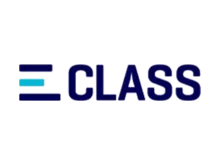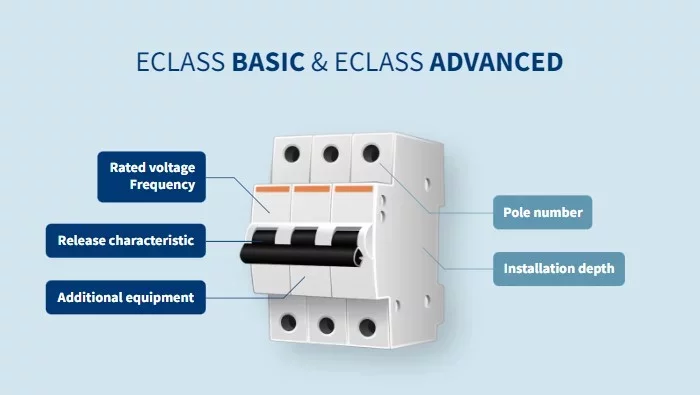By using a unified structure, data is consistent across all systems, regardless of industry, country, language or organization. ECLASS supports an omnichannel strategy by giving a unified model that will communicate the same detailed product data to target channels.
ECLASS (old spelling eCl@ss) is a classification system for products and services. It is the only one to use ISO-compliant standardized features (ISO 13584-42 / IEC 61360 standard), which is why it is sometimes referred to as the common "language" for Industry 4.0.

Classification history
The ECLASS e.V. association was founded on November 14, 2000 by large German industrial companies, they were: Siemens, BASF, Audi/VW, E.ON, SAP, Bayer AG, Degussa, Wacker Chemie, Infraserv Chemfidence and Solvay. Today, in addition to large industrial companies, members include numerous medium-sized companies, as well as large public sector organizations such as the state of North Rhine-Westphalia and the Austrian Federal Procurement Agency.
In 2020, the association had about 150 members worldwide. ECLASS e.V. is a nonprofit organization that defines, develops and disseminates the classification standard and master data of the same name internationally across all industry sectors. In addition to its parent branch in Germany, ECLASS has regional offices throughout Austria, Switzerland, Portugal, Spain, Russia, China, South Korea and the United States.
Issues, licenses and costs
Once a year, a new edition of ECLASS is published. Each new edition represents an update and is machine-readable. In addition to the publication languages (English and German), the classification is translated, for the past eight editions it has been in a total of 16 languages including Polish. The translation does not always cover all parts of the classification. This is the case with the Polish version having 42% of the classes translated, with no translations for the other elements of the classification.
The Single license grants license rights for a single ECLASS release. The Concordance License grants rights for all editions and their files, and has a minimum term of three years. Membership in addition to the Concordance License grants voting rights in the association and work on the association's committee.
There is an option to connect via the REST API. Free option for Membership and Concordance license, extra payment for Single license depending on the number of queries. Payment for 1 or 3 years, details: payments on number of queries and current price list.
BASIC and ADVANCED versions
Customers using the ECLASS standard can choose between a version with one-dimensional features (ECLASS BASIC) or a version with multidimensional feature structures (ECLASS ADVANCED). Both versions are based on the same ISO-compliant data model.
ECLASS BASIC has a flat structure, fewer features, CSV and XML formats. It is more for management, marketing and sales. ECLASS ADVANCED has all features grouped accordingly, XML and JSON formats. Tension and similar technical features are only in Advanced, which is more for production, maintenance, engineering and quality management.

ECLASS design
ECLASS has a four-level hierarchy. The first three levels are a folder structure to facilitate navigation to the fourth level, the class proper. For the ADVANCED version, the class is divided into Blocks/Aspects grouping features, for example, in the demo data the class is divided into 13 Blocks/Aspects. The rest of the data structure is the same in both versions. Property are features that can have Value (dictionary) or Unit (unit of measure). Besides, classes have their alternative names (Keyword) and features have their alternative names (Synonym).
ECLASS contains many types of data, including: textual with specified features to be translated, logical, dates, integers and decimals, URL.
A brief comparison to other product classifications
ETIM and proficl@ss (now part of ETIM) - ECLASS e.V. has already started working with ETIM after just one year of operation. For electrical engineering products, there is a mapping between ECLASS and ETIM classes, which will be expanded, according to the announcement. ECLASS has many data types, compared to ETIM it has in addition, among other things: it has integers and decimals separately, dates, plain and translated (localized) text fields, URLs. In addition, ETIM is fully translated, while in ECLASS the translation only applies to parts of classes and not to features, their values or alternative names.
UNSPSC (United Nations Standard Product and Service Code) - this classification contains a hierarchy of goods and services without details. It competes only as a multi-level hierarchy of classes (here as Goods).
GPC (Global Product Classification) - GPC contains 4-7 descriptive type features (pick lists) while ECLASS contains many more features with much more data types. Both BASIC and ADVANCED versions are more detailed than GPC.
How ECLASS stores information, or tools
Relative to other classifications, ECLASS is more often used in ERP systems, acting as the basic structure of product groups or describing product features and master data. The information goes to subsequent systems, e.g., PIM, MDM, CMS; which, after modifications, will distribute the data to target channels.
Sometimes different business needs can be met by a single tool, an example being PimCore being a PIM system, MDM, CMS, DXP, online catalog or even an e-commerce site. In such a case, you need to decide which system to use as the most reliable source of data, which is where the products will be created.

